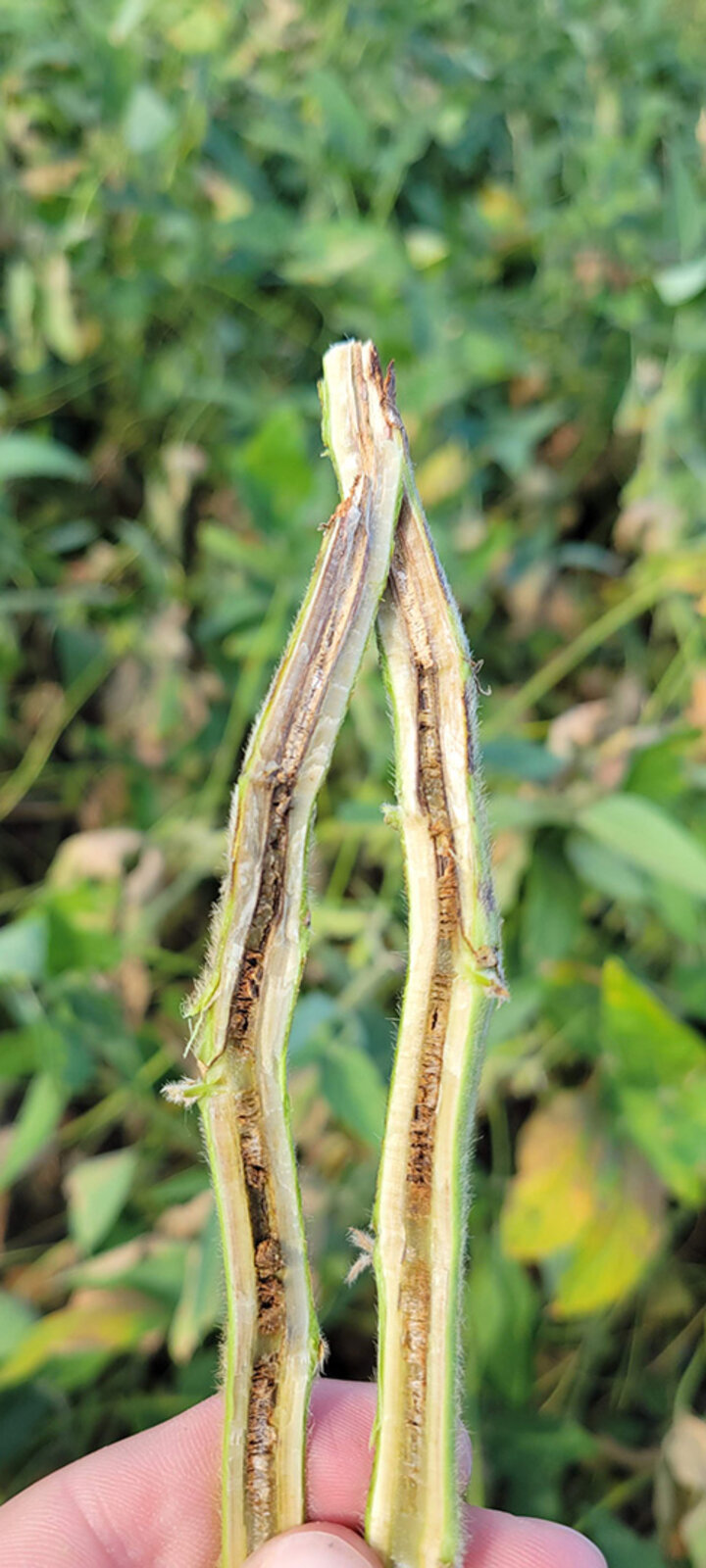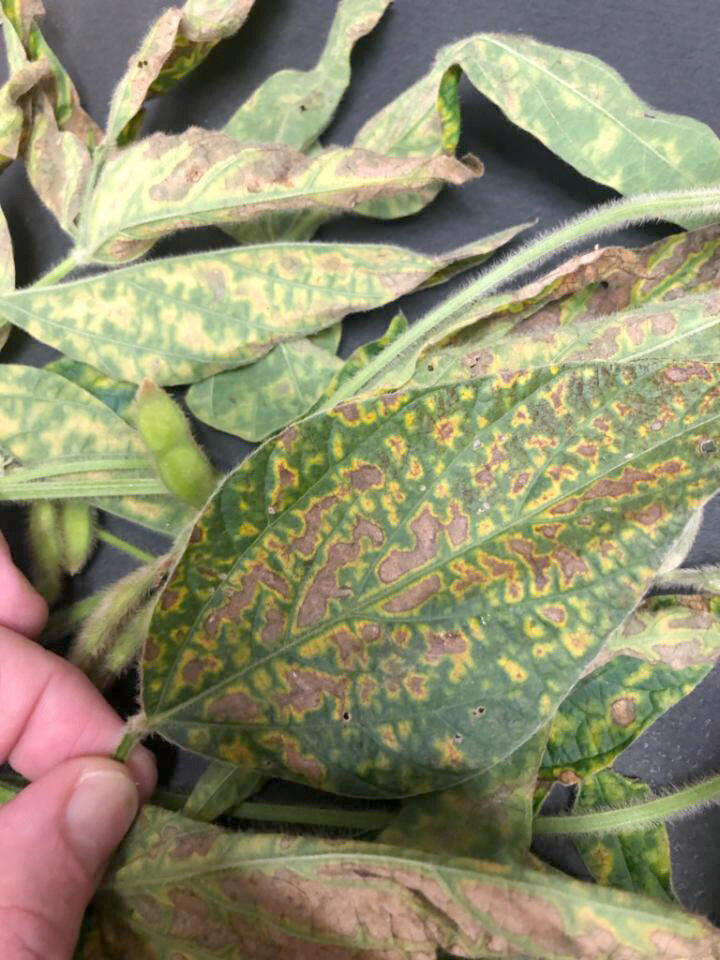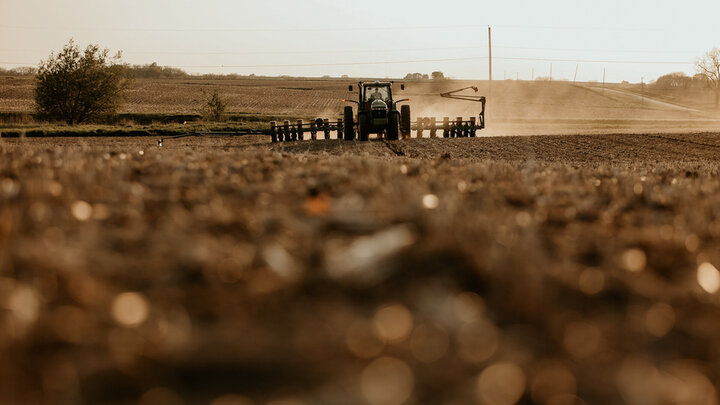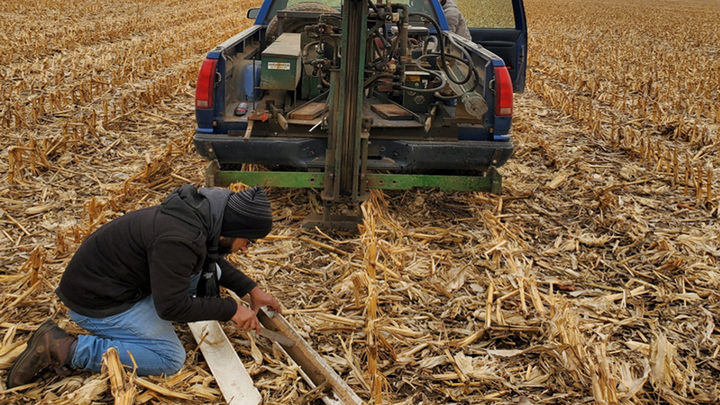By Dylan Mangel, Extension Plant Pathologist
Pathogen
Brown stem rot (BSR) is caused by the fungus Cadophora gregata. The fungus survives in plant residue on which spores are produced from pre-colonized woody stem tissue. Infected plant residue is thought to be the main source of spread for the fungus. Infections occur through the roots and lower stem early in the season and the mycelium grows upward in the water-conducting xylem vessels. Water and nutrient flow are inhibited because the mycelium plugs the xylem vessels.
Disease Symptoms
Symptoms of brown stem rot typically do not occur until mid- to late reproductive stages (R5). Infected plants may not show visible symptoms other than premature death, which may be confused with early maturity or dry weather. Brown stem rot can produce both foliar and stem symptoms. Split stems of infected plants reveal internal browning of the pith and vascular tissue. Pith discoloration starts at the base of the stem and moves upward to the nodes and progresses into the internodal tissues during the growing season.

Later in the season, infected plants may wilt and show external browning on the lower part of the stem. Severely diseased plants may lodge. Leaf symptoms may resemble high temperature "scorch" or drought stress. Leaves on infected plants may develop interveinal chlorotic (yellowish) blotches. Tissue between the veins dies and turns brown, whereas tissue adjacent to veins remains green and is the last to die. This foliar symptom can be confused with sudden death syndrome. Eventually all leaves will curl and die and will remain attached for some time after death. Foliar symptoms will not develop if air temperatures are high during the R3-R4 growth stages. Field distribution will typically be patches or packets of plants being affected.

Favorable Environmental Conditions
Cool weather during soybean reproductive stages favors foliar symptom development; irrigation after flowering increases leaf symptoms. Disease development is greatest between 60°F and 75°F and is suppressed at temperatures above 80°F. Wet soils also favor disease development earlier in the growing season and moisture stress later in the season increases disease severity.
Soybean cyst nematode (SCN) will increase the risk of brown stem rot damage. However, soybean varieties with PI 88788 SCN resistance typically have BSR resistance. Soybean varieties with the ‘Peking’ resistance source may be more susceptible to BSR.
Management
Genetic Resistance
Soybean varieties vary in their susceptibility to brown stem rot. Resistant soybean varieties should be grown in fields with a history of this disease and varieties should be rotated to maintain the effectiveness of the resistance genes.
Cultural Practices
Avoid planting soybeans in severely brown stem rot-infested fields for at least three years. This time allows residue to break down and the fungus cannot survive outside of infested residue. Soybean is the only host for the brown stem rot pathogen.
In no-till systems, longer crop rotations should be used. Additionally, a shredder can be used to break up soybean straw and reduce inoculum.
Additional Resources
Soybean Research and Information Network: Brown Stem Rot
Crop Protection Network: Brown Stem Rot
Information for this page was originally produced by Loren Giesler.
Soybean Diseases
- Soybean Diseases (Home)
- Anthracnose
- Bacterial Blight
- Bacterial Pustule
- Bean Pod Mottle Virus
- Brown Spot
- Brown Stem Rot
- Charcoal Rot
- Frogeye Leaf Spot
- Phytophthora Root and Stem Rot
- Pod and Stem Blight
- Purple Seed Stain
- Rhizoctonia Root Rot
- Sclerotinia Stem Rot
- Soybean Cyst Nematode (SCN)
- Soybean Mosaic Virus
- Soybean Rust
- Stem Canker
- Sudden Death Syndrome (SDS)








